HRM: Demonstrating AHRI Model of Excellence Capabilities
VerifiedAdded on 2023/06/15
|7
|1504
|163
Essay
AI Summary
This essay delves into the AHRI Model of Excellence, focusing on three key capabilities essential for HR practitioners: business-driven approach, expert practitioner skills, and culture and change leadership. The author reflects on their experiences, illustrating how they have applied these capabilities in previous roles, such as performance appraisal, negotiation, and change management. The essay highlights the importance of understanding organizational objectives, resolving employee issues, and fostering organizational changes to achieve long-term sustainability and competitive advantage. Ultimately, the author positions themselves as a suitable candidate for a graduate HR position by demonstrating proficiency in these critical areas.
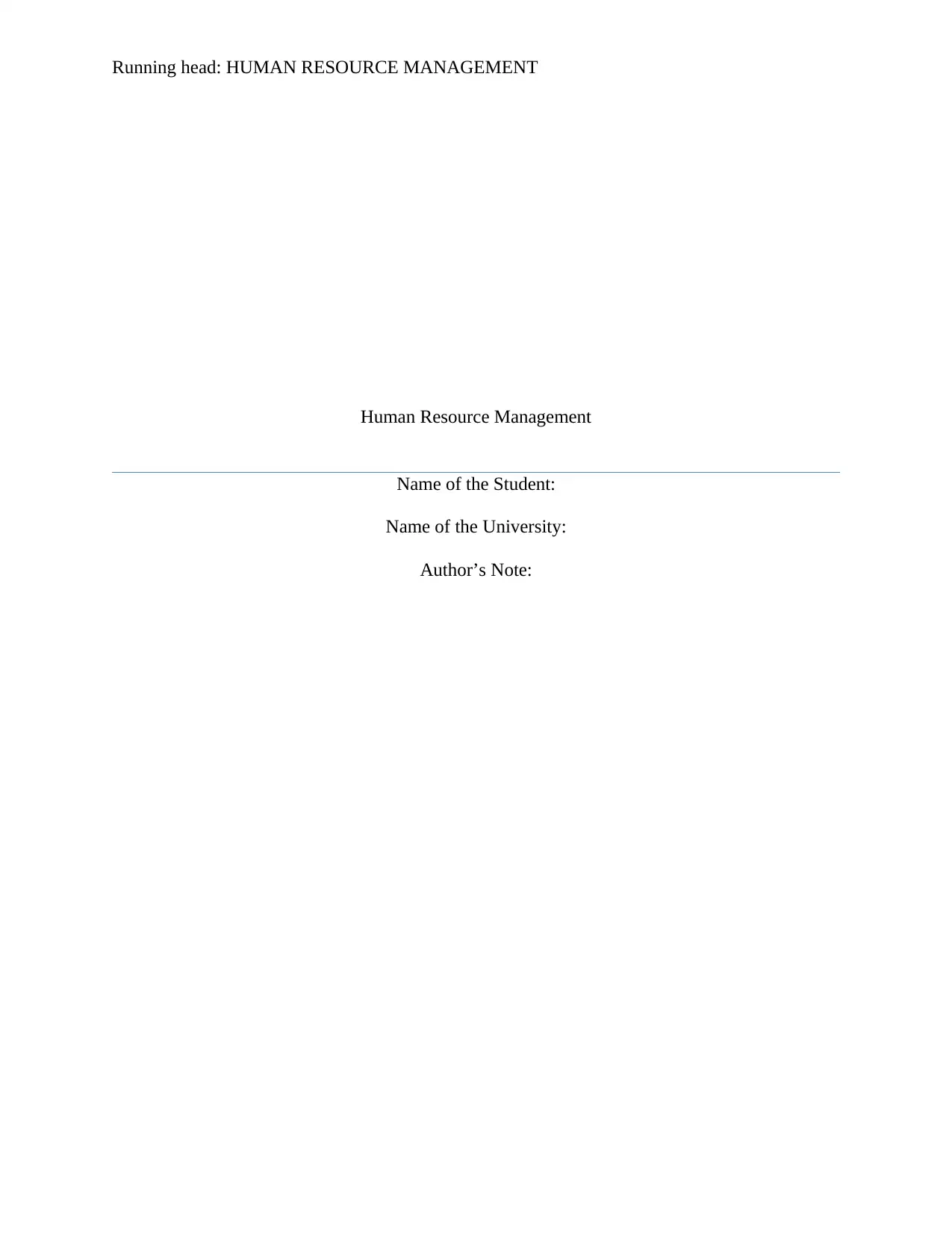
Running head: HUMAN RESOURCE MANAGEMENT
Human Resource Management
Name of the Student:
Name of the University:
Author’s Note:
Human Resource Management
Name of the Student:
Name of the University:
Author’s Note:
Paraphrase This Document
Need a fresh take? Get an instant paraphrase of this document with our AI Paraphraser
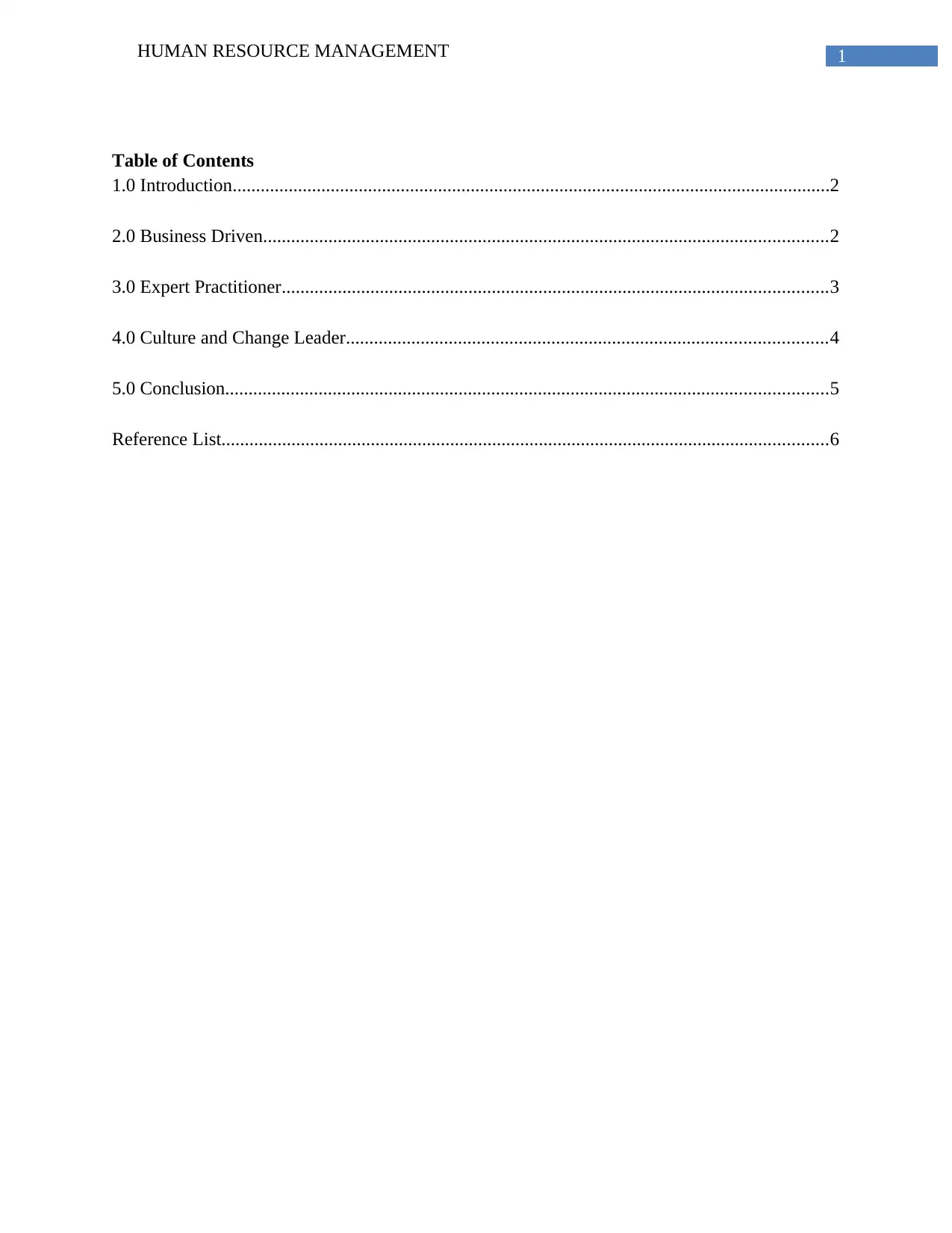
1HUMAN RESOURCE MANAGEMENT
Table of Contents
1.0 Introduction................................................................................................................................2
2.0 Business Driven.........................................................................................................................2
3.0 Expert Practitioner.....................................................................................................................3
4.0 Culture and Change Leader.......................................................................................................4
5.0 Conclusion.................................................................................................................................5
Reference List..................................................................................................................................6
Table of Contents
1.0 Introduction................................................................................................................................2
2.0 Business Driven.........................................................................................................................2
3.0 Expert Practitioner.....................................................................................................................3
4.0 Culture and Change Leader.......................................................................................................4
5.0 Conclusion.................................................................................................................................5
Reference List..................................................................................................................................6
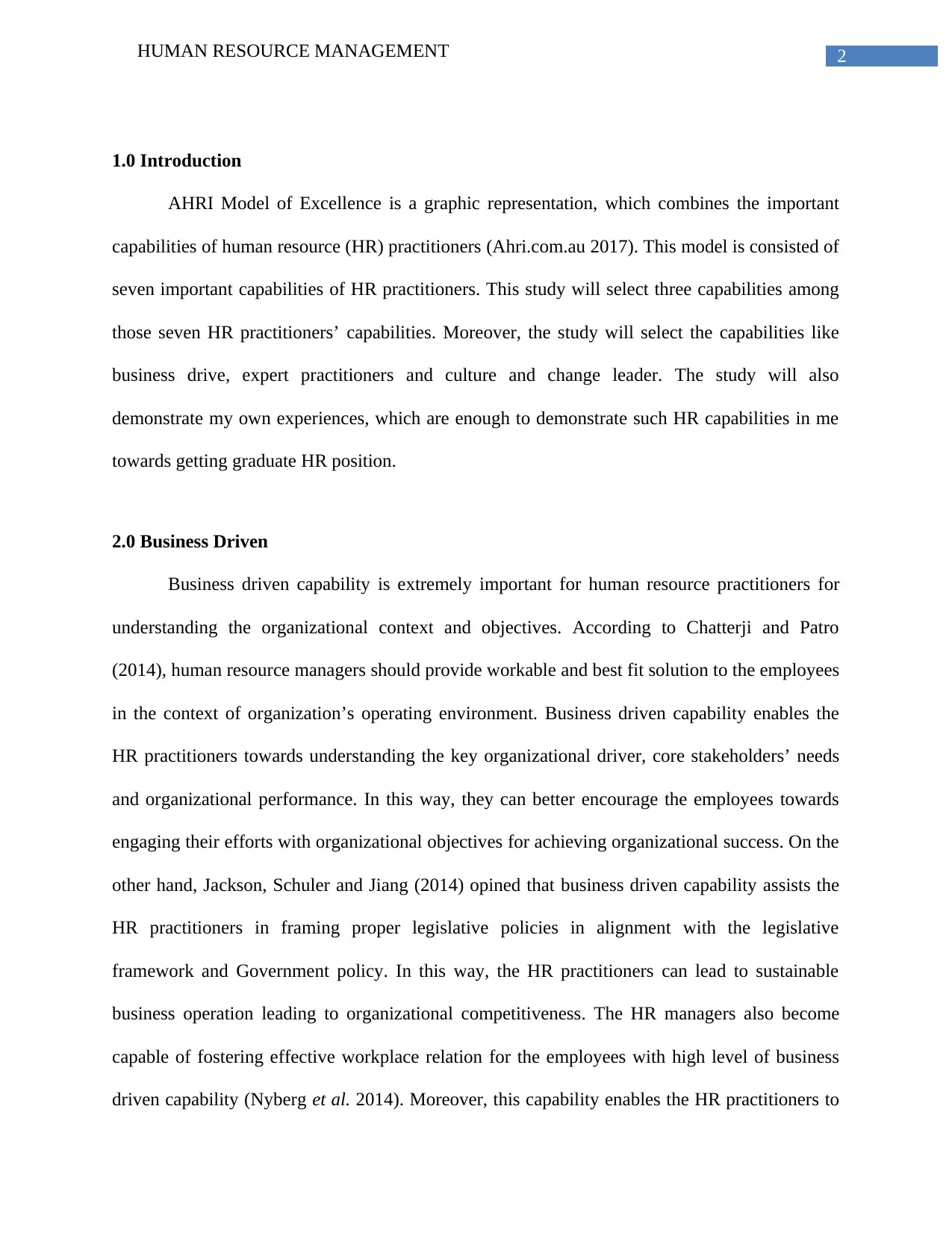
2HUMAN RESOURCE MANAGEMENT
1.0 Introduction
AHRI Model of Excellence is a graphic representation, which combines the important
capabilities of human resource (HR) practitioners (Ahri.com.au 2017). This model is consisted of
seven important capabilities of HR practitioners. This study will select three capabilities among
those seven HR practitioners’ capabilities. Moreover, the study will select the capabilities like
business drive, expert practitioners and culture and change leader. The study will also
demonstrate my own experiences, which are enough to demonstrate such HR capabilities in me
towards getting graduate HR position.
2.0 Business Driven
Business driven capability is extremely important for human resource practitioners for
understanding the organizational context and objectives. According to Chatterji and Patro
(2014), human resource managers should provide workable and best fit solution to the employees
in the context of organization’s operating environment. Business driven capability enables the
HR practitioners towards understanding the key organizational driver, core stakeholders’ needs
and organizational performance. In this way, they can better encourage the employees towards
engaging their efforts with organizational objectives for achieving organizational success. On the
other hand, Jackson, Schuler and Jiang (2014) opined that business driven capability assists the
HR practitioners in framing proper legislative policies in alignment with the legislative
framework and Government policy. In this way, the HR practitioners can lead to sustainable
business operation leading to organizational competitiveness. The HR managers also become
capable of fostering effective workplace relation for the employees with high level of business
driven capability (Nyberg et al. 2014). Moreover, this capability enables the HR practitioners to
1.0 Introduction
AHRI Model of Excellence is a graphic representation, which combines the important
capabilities of human resource (HR) practitioners (Ahri.com.au 2017). This model is consisted of
seven important capabilities of HR practitioners. This study will select three capabilities among
those seven HR practitioners’ capabilities. Moreover, the study will select the capabilities like
business drive, expert practitioners and culture and change leader. The study will also
demonstrate my own experiences, which are enough to demonstrate such HR capabilities in me
towards getting graduate HR position.
2.0 Business Driven
Business driven capability is extremely important for human resource practitioners for
understanding the organizational context and objectives. According to Chatterji and Patro
(2014), human resource managers should provide workable and best fit solution to the employees
in the context of organization’s operating environment. Business driven capability enables the
HR practitioners towards understanding the key organizational driver, core stakeholders’ needs
and organizational performance. In this way, they can better encourage the employees towards
engaging their efforts with organizational objectives for achieving organizational success. On the
other hand, Jackson, Schuler and Jiang (2014) opined that business driven capability assists the
HR practitioners in framing proper legislative policies in alignment with the legislative
framework and Government policy. In this way, the HR practitioners can lead to sustainable
business operation leading to organizational competitiveness. The HR managers also become
capable of fostering effective workplace relation for the employees with high level of business
driven capability (Nyberg et al. 2014). Moreover, this capability enables the HR practitioners to
⊘ This is a preview!⊘
Do you want full access?
Subscribe today to unlock all pages.

Trusted by 1+ million students worldwide
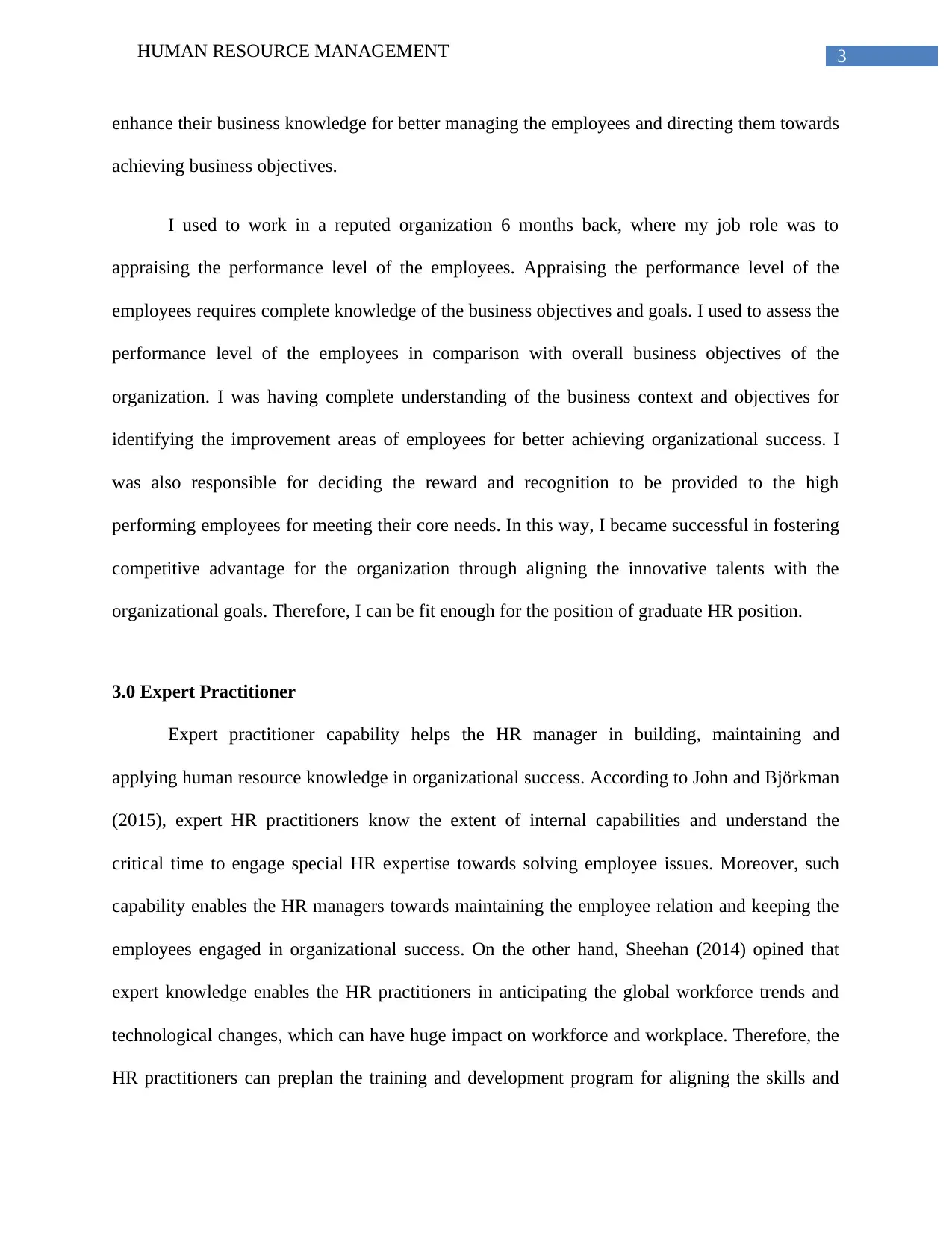
3HUMAN RESOURCE MANAGEMENT
enhance their business knowledge for better managing the employees and directing them towards
achieving business objectives.
I used to work in a reputed organization 6 months back, where my job role was to
appraising the performance level of the employees. Appraising the performance level of the
employees requires complete knowledge of the business objectives and goals. I used to assess the
performance level of the employees in comparison with overall business objectives of the
organization. I was having complete understanding of the business context and objectives for
identifying the improvement areas of employees for better achieving organizational success. I
was also responsible for deciding the reward and recognition to be provided to the high
performing employees for meeting their core needs. In this way, I became successful in fostering
competitive advantage for the organization through aligning the innovative talents with the
organizational goals. Therefore, I can be fit enough for the position of graduate HR position.
3.0 Expert Practitioner
Expert practitioner capability helps the HR manager in building, maintaining and
applying human resource knowledge in organizational success. According to John and Björkman
(2015), expert HR practitioners know the extent of internal capabilities and understand the
critical time to engage special HR expertise towards solving employee issues. Moreover, such
capability enables the HR managers towards maintaining the employee relation and keeping the
employees engaged in organizational success. On the other hand, Sheehan (2014) opined that
expert knowledge enables the HR practitioners in anticipating the global workforce trends and
technological changes, which can have huge impact on workforce and workplace. Therefore, the
HR practitioners can preplan the training and development program for aligning the skills and
enhance their business knowledge for better managing the employees and directing them towards
achieving business objectives.
I used to work in a reputed organization 6 months back, where my job role was to
appraising the performance level of the employees. Appraising the performance level of the
employees requires complete knowledge of the business objectives and goals. I used to assess the
performance level of the employees in comparison with overall business objectives of the
organization. I was having complete understanding of the business context and objectives for
identifying the improvement areas of employees for better achieving organizational success. I
was also responsible for deciding the reward and recognition to be provided to the high
performing employees for meeting their core needs. In this way, I became successful in fostering
competitive advantage for the organization through aligning the innovative talents with the
organizational goals. Therefore, I can be fit enough for the position of graduate HR position.
3.0 Expert Practitioner
Expert practitioner capability helps the HR manager in building, maintaining and
applying human resource knowledge in organizational success. According to John and Björkman
(2015), expert HR practitioners know the extent of internal capabilities and understand the
critical time to engage special HR expertise towards solving employee issues. Moreover, such
capability enables the HR managers towards maintaining the employee relation and keeping the
employees engaged in organizational success. On the other hand, Sheehan (2014) opined that
expert knowledge enables the HR practitioners in anticipating the global workforce trends and
technological changes, which can have huge impact on workforce and workplace. Therefore, the
HR practitioners can preplan the training and development program for aligning the skills and
Paraphrase This Document
Need a fresh take? Get an instant paraphrase of this document with our AI Paraphraser
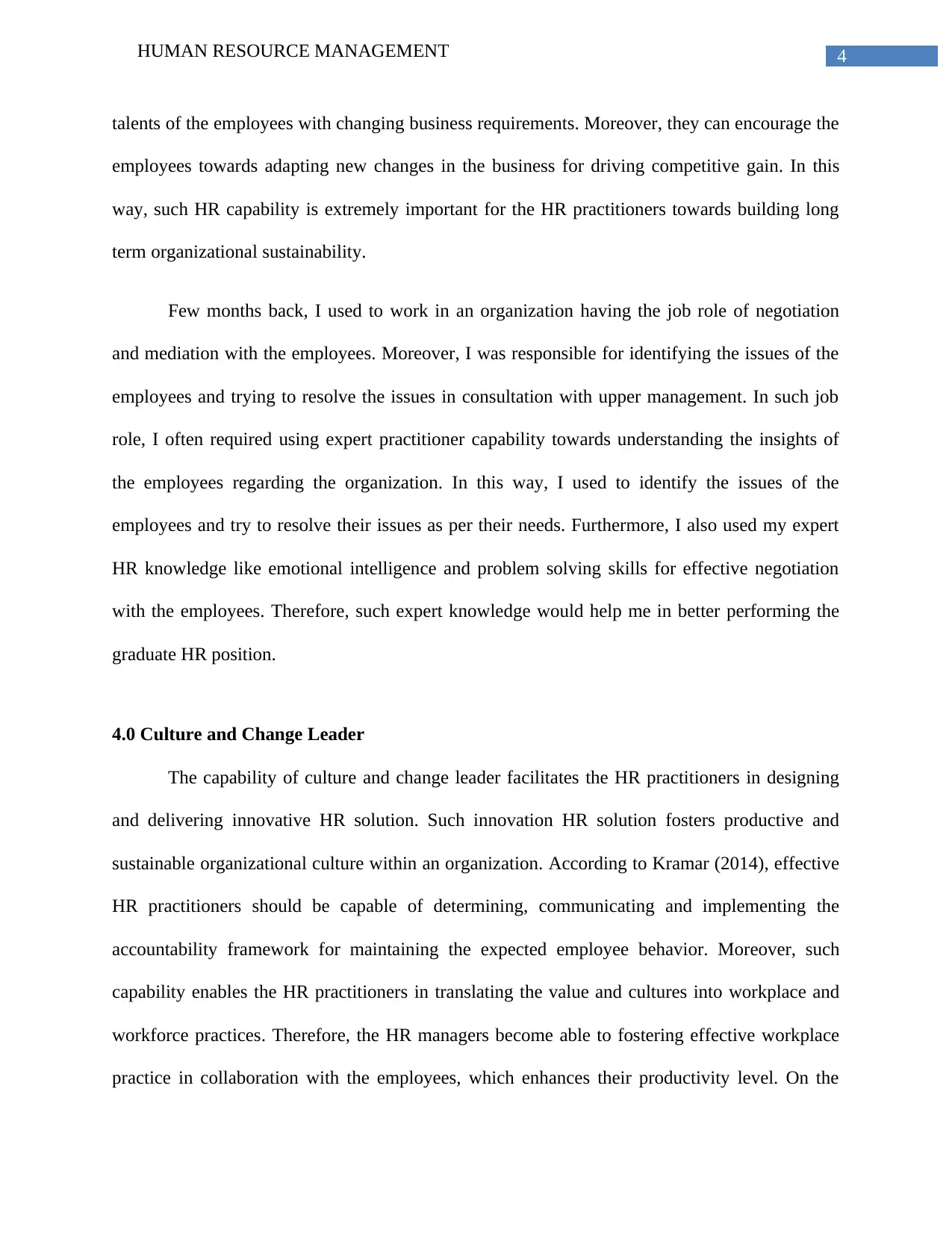
4HUMAN RESOURCE MANAGEMENT
talents of the employees with changing business requirements. Moreover, they can encourage the
employees towards adapting new changes in the business for driving competitive gain. In this
way, such HR capability is extremely important for the HR practitioners towards building long
term organizational sustainability.
Few months back, I used to work in an organization having the job role of negotiation
and mediation with the employees. Moreover, I was responsible for identifying the issues of the
employees and trying to resolve the issues in consultation with upper management. In such job
role, I often required using expert practitioner capability towards understanding the insights of
the employees regarding the organization. In this way, I used to identify the issues of the
employees and try to resolve their issues as per their needs. Furthermore, I also used my expert
HR knowledge like emotional intelligence and problem solving skills for effective negotiation
with the employees. Therefore, such expert knowledge would help me in better performing the
graduate HR position.
4.0 Culture and Change Leader
The capability of culture and change leader facilitates the HR practitioners in designing
and delivering innovative HR solution. Such innovation HR solution fosters productive and
sustainable organizational culture within an organization. According to Kramar (2014), effective
HR practitioners should be capable of determining, communicating and implementing the
accountability framework for maintaining the expected employee behavior. Moreover, such
capability enables the HR practitioners in translating the value and cultures into workplace and
workforce practices. Therefore, the HR managers become able to fostering effective workplace
practice in collaboration with the employees, which enhances their productivity level. On the
talents of the employees with changing business requirements. Moreover, they can encourage the
employees towards adapting new changes in the business for driving competitive gain. In this
way, such HR capability is extremely important for the HR practitioners towards building long
term organizational sustainability.
Few months back, I used to work in an organization having the job role of negotiation
and mediation with the employees. Moreover, I was responsible for identifying the issues of the
employees and trying to resolve the issues in consultation with upper management. In such job
role, I often required using expert practitioner capability towards understanding the insights of
the employees regarding the organization. In this way, I used to identify the issues of the
employees and try to resolve their issues as per their needs. Furthermore, I also used my expert
HR knowledge like emotional intelligence and problem solving skills for effective negotiation
with the employees. Therefore, such expert knowledge would help me in better performing the
graduate HR position.
4.0 Culture and Change Leader
The capability of culture and change leader facilitates the HR practitioners in designing
and delivering innovative HR solution. Such innovation HR solution fosters productive and
sustainable organizational culture within an organization. According to Kramar (2014), effective
HR practitioners should be capable of determining, communicating and implementing the
accountability framework for maintaining the expected employee behavior. Moreover, such
capability enables the HR practitioners in translating the value and cultures into workplace and
workforce practices. Therefore, the HR managers become able to fostering effective workplace
practice in collaboration with the employees, which enhances their productivity level. On the
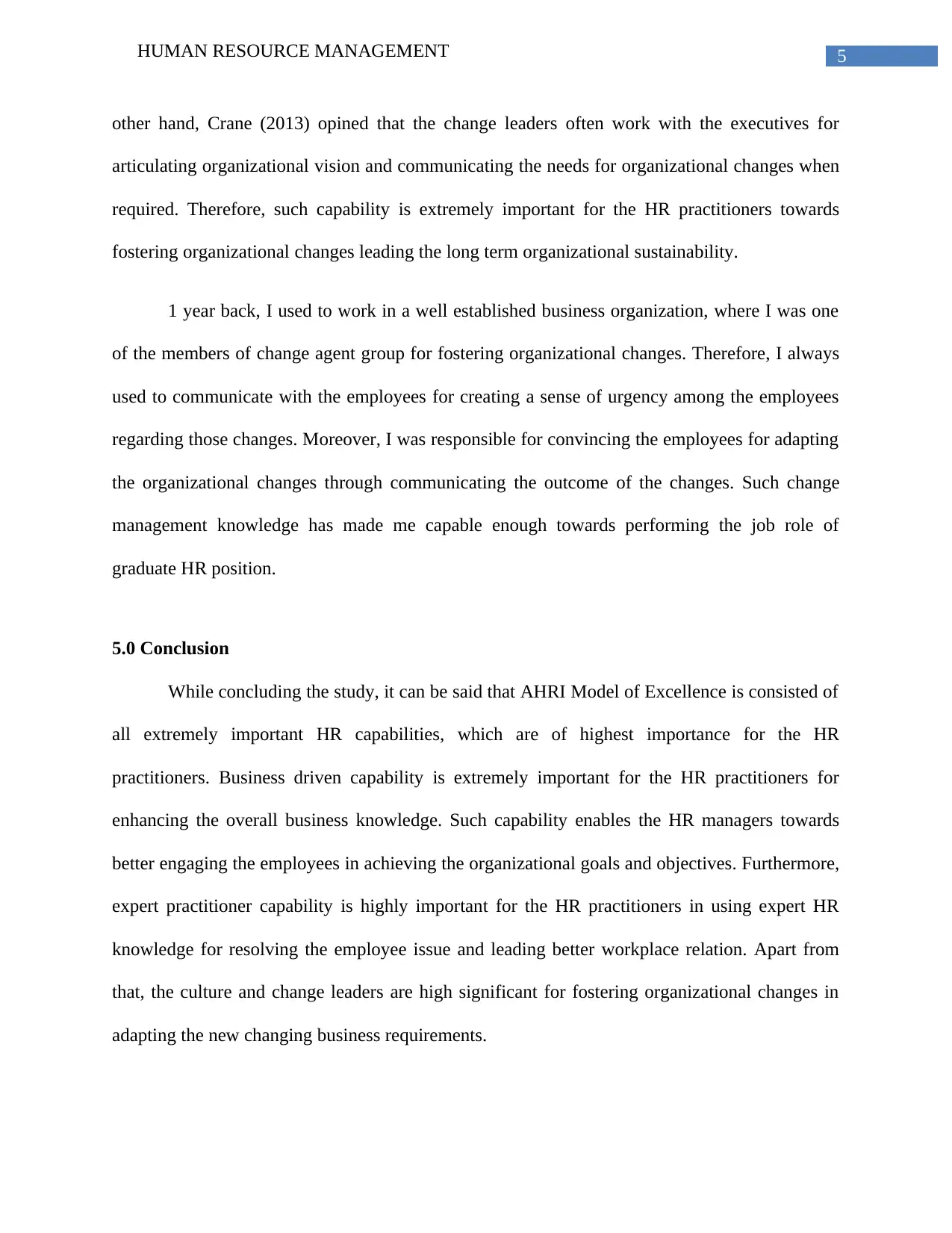
5HUMAN RESOURCE MANAGEMENT
other hand, Crane (2013) opined that the change leaders often work with the executives for
articulating organizational vision and communicating the needs for organizational changes when
required. Therefore, such capability is extremely important for the HR practitioners towards
fostering organizational changes leading the long term organizational sustainability.
1 year back, I used to work in a well established business organization, where I was one
of the members of change agent group for fostering organizational changes. Therefore, I always
used to communicate with the employees for creating a sense of urgency among the employees
regarding those changes. Moreover, I was responsible for convincing the employees for adapting
the organizational changes through communicating the outcome of the changes. Such change
management knowledge has made me capable enough towards performing the job role of
graduate HR position.
5.0 Conclusion
While concluding the study, it can be said that AHRI Model of Excellence is consisted of
all extremely important HR capabilities, which are of highest importance for the HR
practitioners. Business driven capability is extremely important for the HR practitioners for
enhancing the overall business knowledge. Such capability enables the HR managers towards
better engaging the employees in achieving the organizational goals and objectives. Furthermore,
expert practitioner capability is highly important for the HR practitioners in using expert HR
knowledge for resolving the employee issue and leading better workplace relation. Apart from
that, the culture and change leaders are high significant for fostering organizational changes in
adapting the new changing business requirements.
other hand, Crane (2013) opined that the change leaders often work with the executives for
articulating organizational vision and communicating the needs for organizational changes when
required. Therefore, such capability is extremely important for the HR practitioners towards
fostering organizational changes leading the long term organizational sustainability.
1 year back, I used to work in a well established business organization, where I was one
of the members of change agent group for fostering organizational changes. Therefore, I always
used to communicate with the employees for creating a sense of urgency among the employees
regarding those changes. Moreover, I was responsible for convincing the employees for adapting
the organizational changes through communicating the outcome of the changes. Such change
management knowledge has made me capable enough towards performing the job role of
graduate HR position.
5.0 Conclusion
While concluding the study, it can be said that AHRI Model of Excellence is consisted of
all extremely important HR capabilities, which are of highest importance for the HR
practitioners. Business driven capability is extremely important for the HR practitioners for
enhancing the overall business knowledge. Such capability enables the HR managers towards
better engaging the employees in achieving the organizational goals and objectives. Furthermore,
expert practitioner capability is highly important for the HR practitioners in using expert HR
knowledge for resolving the employee issue and leading better workplace relation. Apart from
that, the culture and change leaders are high significant for fostering organizational changes in
adapting the new changing business requirements.
⊘ This is a preview!⊘
Do you want full access?
Subscribe today to unlock all pages.

Trusted by 1+ million students worldwide
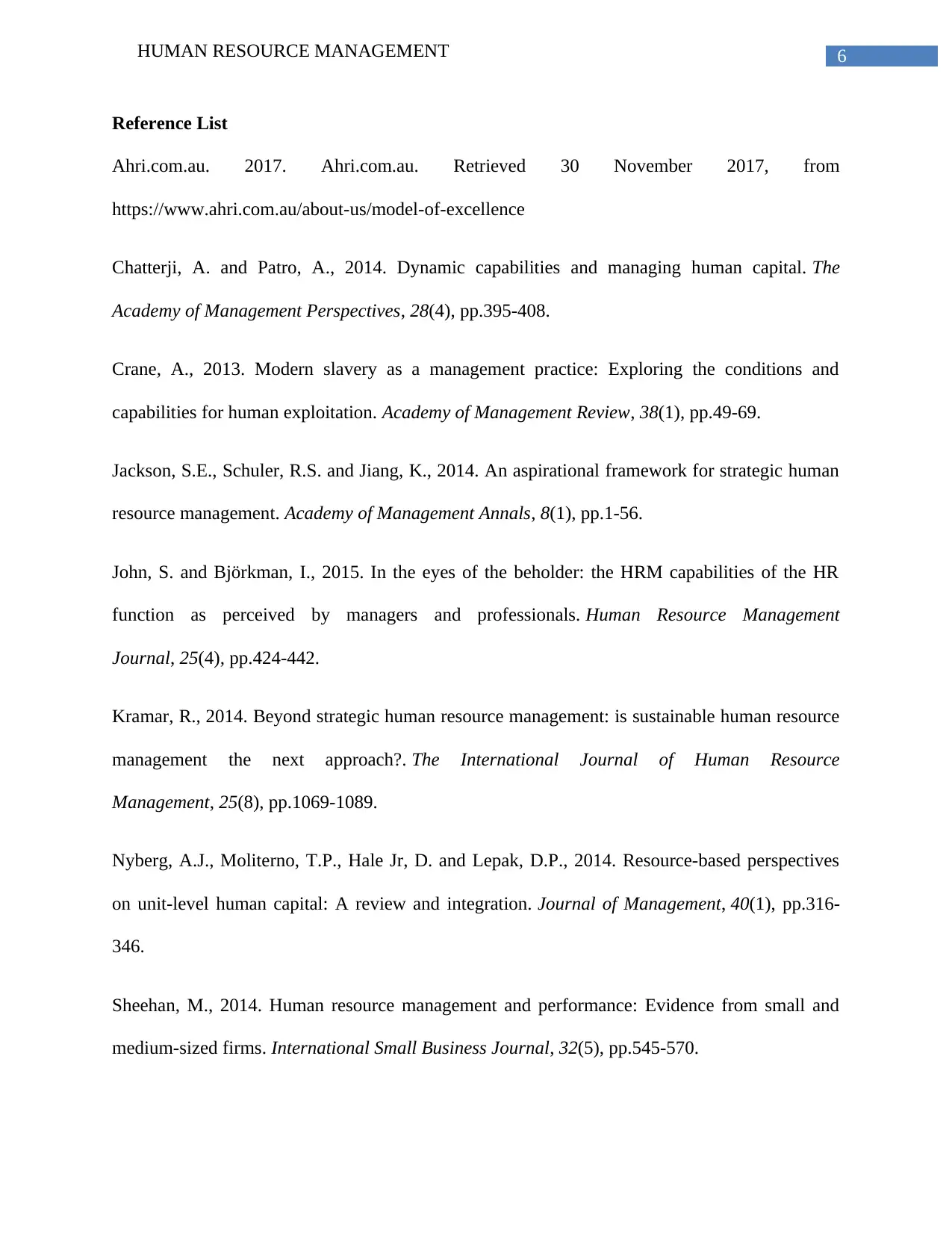
6HUMAN RESOURCE MANAGEMENT
Reference List
Ahri.com.au. 2017. Ahri.com.au. Retrieved 30 November 2017, from
https://www.ahri.com.au/about-us/model-of-excellence
Chatterji, A. and Patro, A., 2014. Dynamic capabilities and managing human capital. The
Academy of Management Perspectives, 28(4), pp.395-408.
Crane, A., 2013. Modern slavery as a management practice: Exploring the conditions and
capabilities for human exploitation. Academy of Management Review, 38(1), pp.49-69.
Jackson, S.E., Schuler, R.S. and Jiang, K., 2014. An aspirational framework for strategic human
resource management. Academy of Management Annals, 8(1), pp.1-56.
John, S. and Björkman, I., 2015. In the eyes of the beholder: the HRM capabilities of the HR
function as perceived by managers and professionals. Human Resource Management
Journal, 25(4), pp.424-442.
Kramar, R., 2014. Beyond strategic human resource management: is sustainable human resource
management the next approach?. The International Journal of Human Resource
Management, 25(8), pp.1069-1089.
Nyberg, A.J., Moliterno, T.P., Hale Jr, D. and Lepak, D.P., 2014. Resource-based perspectives
on unit-level human capital: A review and integration. Journal of Management, 40(1), pp.316-
346.
Sheehan, M., 2014. Human resource management and performance: Evidence from small and
medium-sized firms. International Small Business Journal, 32(5), pp.545-570.
Reference List
Ahri.com.au. 2017. Ahri.com.au. Retrieved 30 November 2017, from
https://www.ahri.com.au/about-us/model-of-excellence
Chatterji, A. and Patro, A., 2014. Dynamic capabilities and managing human capital. The
Academy of Management Perspectives, 28(4), pp.395-408.
Crane, A., 2013. Modern slavery as a management practice: Exploring the conditions and
capabilities for human exploitation. Academy of Management Review, 38(1), pp.49-69.
Jackson, S.E., Schuler, R.S. and Jiang, K., 2014. An aspirational framework for strategic human
resource management. Academy of Management Annals, 8(1), pp.1-56.
John, S. and Björkman, I., 2015. In the eyes of the beholder: the HRM capabilities of the HR
function as perceived by managers and professionals. Human Resource Management
Journal, 25(4), pp.424-442.
Kramar, R., 2014. Beyond strategic human resource management: is sustainable human resource
management the next approach?. The International Journal of Human Resource
Management, 25(8), pp.1069-1089.
Nyberg, A.J., Moliterno, T.P., Hale Jr, D. and Lepak, D.P., 2014. Resource-based perspectives
on unit-level human capital: A review and integration. Journal of Management, 40(1), pp.316-
346.
Sheehan, M., 2014. Human resource management and performance: Evidence from small and
medium-sized firms. International Small Business Journal, 32(5), pp.545-570.
1 out of 7
Related Documents
Your All-in-One AI-Powered Toolkit for Academic Success.
+13062052269
info@desklib.com
Available 24*7 on WhatsApp / Email
![[object Object]](/_next/static/media/star-bottom.7253800d.svg)
Unlock your academic potential
Copyright © 2020–2025 A2Z Services. All Rights Reserved. Developed and managed by ZUCOL.





